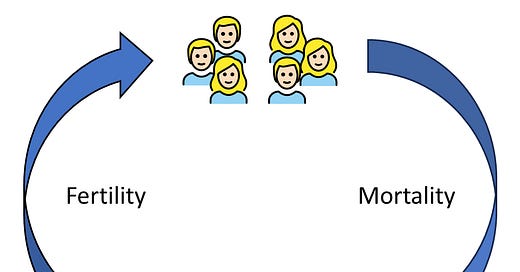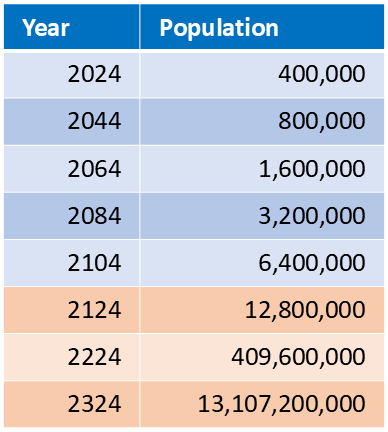Demographic transition theory (DTT) claims that humanity is going through a transition from high fertility and high child mortality to low fertility and low child mortality. Supposedly, this transition will result in a new stable equilibrium.
From Two centuries of rapid global population growth will come to an end by Max Roser and Hannah Ritchie:
We are on the way to a new balance. The big global demographic transition that the world entered more than two centuries ago is then coming to an end. This new equilibrium is different from the one in the past when it was the very high mortality that kept population growth in check. In the new balance, it will be low fertility that keeps population changes small.
DTT is generally accepted and rarely challenged. In this essay, I will debunk it.
In the past, high fertility was balanced by high premature mortality. That is how populations are normally regulated. Population growth increases the competition for scarce resources, which makes life harder, causing increased premature mortality. Eventually, a balance is reached between fertility and premature mortality. At that point, the population is stable.
DTT claims that we are transitioning to a new stable equilibrium, in which voluntary low fertility prevents population growth. This claim is false, because voluntary low fertility is not stable.
Modern civilization is not in a stable state. We are going through a phase of rapid growth, due to the exploitation of new resources — mainly fossil fuels. This growth phase cannot continue forever. It will probably end soon.
We are also going through a fertility collapse. This complicates the picture. But the fertility collapse is not a transition to a new stable state. It is a systematic malfunctioning of human nature in the modern environment.
Another thing that complicates the picture is that human beings are complicated. We are capable of doing strange things, such as choosing not to reproduce.
There are two reasons why DTT is wrong:
Voluntary low fertility is maladaptive, so it will be corrected by evolution. Breeders will replace non-breeders.
Relaxed selection allows mutations to accumulate, degrading the genome.
Let’s start with the first one. Voluntary low fertility is maladaptive, so it will be corrected by evolution, one way or another.
Those who have the most children pass on the most copies of their genes. Conversely, those who have few or no children pass on few or no copies of their genes. In modern civilization, almost all children live to adulthood, making high fertility much more adaptive than low fertility.
There is no gene that “codes” for high fertility versus low fertility. But the brain is determined by genes. Different genes produce different mental traits. There are almost certainly some genetic variants that correlate with high or low fertility in the modern environment, and those variants are now under strong selective pressure.
Currently, voluntary low fertility is the biggest obstacle to reproduction for human beings. Thus, it is now the driving force of selection for human beings. Now that we have effective birth control, reproductive fitness is mostly determined by the choice to reproduce.
Of course, human behavior is not entirely determined by genes. It also depends on culture. This is where the story gets more complicated, due to human complexity. There are memes that promote high fertility and memes that promote low fertility.
Culture evolves by a process that is analogous to biological evolution. Memes are selected to propagate from brain to brain. There are essentially two ways for memes to propagate: from parents to children, or between peers. We can divide memes into two categories: traditions and fashions. Traditions propagate mostly from parents to children. Fashions propagate mostly between unrelated people.
This is a simplified view of memetics, but it is sufficient for this essay.
Traditions tend to promote reproduction, or at least not interfere with it, because they propagate from parents to children. Fashions, on the other hand, can evolve to propagate at the expense of their hosts. They can be parasitic. An antinatalist fashion can evolve.
These days, it is very easy for fashions to propagate through the network of human brains connected by communication media. Parasitic memes have evolved to exploit this new cultural environment.
To some extent, voluntary low fertility is a parasitic meme that spreads by communication and imitation. But it is mostly due to biological mismatch. We did not evolve to have effective birth control at our disposal.
See The Paradox of Low Fertility.
Either way, we can think of voluntary low fertility as a disease. Currently, this disease is spreading rapidly through the human population. However, like any disease, it selects for genetic resistance to it. Those who resist infection pass on more of their genes to the next generation.
Meanwhile, adaptive traditions are increasing by reproduction. For example, the Amish population is growing rapidly. Being Amish is a heritable trait, regardless of whether it is cultural or biological. It is probably both: a gene-meme complex.
Somewhat ironically, an Amish farmer is well-adapted to modern civilization, while the typical liberal urbanite is very badly adapted to modern civilization.
Currently, the Amish population doubles roughly every 20 years. At that rate of growth, the Amish population will grow as follows (roughly):
In 100 years, it will increase to roughly 13 million. In 200 years, it will be over 400 million. In 300 years, it will be over 13 billion.
I don’t think that is going to happen. Something will stop the growth of the Amish population before it reaches 13 billion. But this shows that the current system is far from stable. Some types of people are increasing rapidly, while others are fading away.
Voluntary low fertility is unstable because it is not adaptive. It will be eliminated by evolution, if modern civilization lasts long enough for that to happen.
Now, let’s consider the other reason why DTT is wrong. Relaxed selection causes the genome to degrade.
DNA copying is not perfect. Mutations occur. Most mutations are maladaptive. They make it harder for an organism to survive to adulthood. So, they are removed by selection. Together, high fertility and harsh selection maintain the order of the genome.
Without harsh selection, mutations accumulate. Eventually, this will increase the rate of premature death. Instead of dying from war, hunger or infectious disease, children will die from genetic disorders. We can try to eliminate the harshness of life with abundant food, medical care, etc. But it will eventually return via the degradation of the genome.
We can imagine extreme technological solutions to the problem of genome degradation, such as “printing” the DNA for a child and inserting it into a zygote. Aside from such extreme measures, it would be almost impossible to eliminate all mutations from the genome. There is no way to find and fix them.
To maintain the genome, there must be excess reproduction that is balanced by selection.
DTT is a liberal-humanist fantasy. It is based on ignoring or denying the implications of evolution for humanity.
There is a way to regulate the population and the genome without high child mortality. I will present it in another essay.
If you found this interesting, please like, subscribe, share, etc.







It's nice to see this posted on Substack.
Polygenic embryo selection shows strong promise for significantly slowing down or even reversing the degradation of the genome, increasing fertility rates, and promoting eugenics. Jonathan Anomaly has done a lot of great writing about this, and I heard that he's planning to launch an embryo selection company sometime later this year. https://jonathan-anomaly.com/
China and Israel have already subsidized IVF nationwide, which has made embryo selection more accessible and affordable in those countries. IVF is expensive, but Western countries should be doing the same since it has a great return on investment.
Like this comment if this essay made you stop believing in DTT